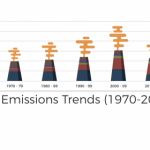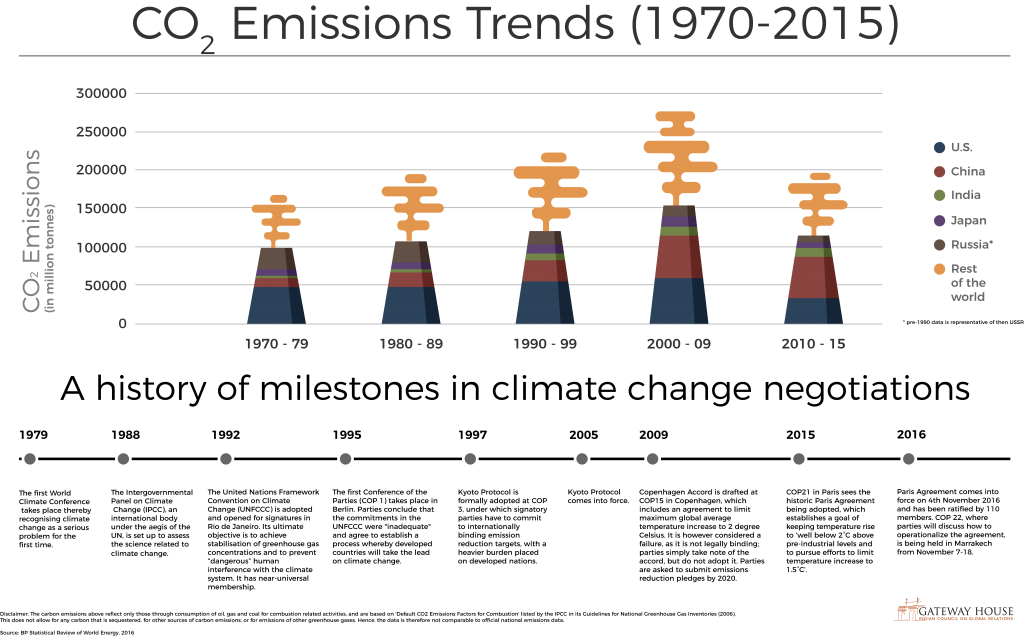The graph above shows clearly that carbon dioxide (CO2) emissions are increasing at an alarming rate worldwide.
The United States has been the biggest culprit for decades, but China is turning a close contender. In the 2000s, China’s emissions nearly doubled on the previous decade’s figures, going from 28 billion tonnes to 56 billion tonnes. This decade, it has become the world’s largest emitter: 53 billion tonnes to the United States’ 33 billion. The two countries together accounted for nearly 44% of CO2 emissions released so far this decade; the remaining three, India, Japan, and Russia, trail far behind them.
It was prior to the signing of the historic COP21 Paris Agreement in 2015 that countries released their Intended Nationally Determined Contributions (INDCs) or projections of emission cuts. The United States declared its target of reducing emissions by 26-28% below 2005 levels by 2025, with the Obama administration planning to implement the Climate Action Plan and Clean Power Plan. These aim to reduce emissions from the power sector by setting individual state targets and introducing carbon pollution standards for power plants. But President-elect Donald Trump’s stated intention to pull the United States out of the climate change agreement could derail these objectives.
China announced that it would peak its carbon dioxide emissions around 2030, or earlier, increase the share of non-fossil fuels in its primary energy mix to around 20% by that date, and lower the carbon intensity of its GDP by 60-65% below 2005 levels by 2030. The Chinese government has begun replacing coal use with gas and setting defined targets for renewables, including solar, wind, biomass and nuclear power, among others. It is also expected to announce a cap and trade system on carbon emissions in 2017.
| Country | INDC |
| India | Reduce emissions intensity by 33-35% below the 2005 level. |
| Japan | Reduce emissions by 25.4% below 2005 levels. |
| Russia | Reduce emissions by 25% to 30% below 1990 levels by 2030. |
| China | Reduce the carbon intensity of its GDP by 60-65% below 2005 levels by 2030. |
| U.S. | Reduce emissions by 26-28% below 2005 levels by 2025. |
India, at 11 billion tonnes this decade, is much less culpable, but emissions have been nearly doubling every decade. In 2015, it announced that the goal was to reduce emissions intensity by 33-35% below the 2005 level and that 40% of its electricity would come from renewable sources by 2030. The Modi administration has planned several measures to achieve this goal, such as increasing the share of natural gas in the country’s energy basket by launching awareness campaigns: the Gas4India campaign is an example. It has also increased the targets for renewable energy use and imposed a coal tax of Rs. 400 per tonne to discourage consumption of coal fired power, and is planning to install ‘supercritical technology’ in new and existing power plants that will generate more electricity from less fuel, thereby increasing energy efficiency .
Japan has pledged to reduce emissions to 25.4% below 2005 levels. To fulfill its INDC pledge, the Basic Energy Plan of 2014 increased the country’s reliance on nuclear energy after power plants were closed in the wake of the 2011 Fukushima earthquake and new safety standards were met.
Russia, for its part, has proposed to reduce emissions to 25% to 30% below 1990 levels by 2030. The government has set a target of 2.5% as the proportion of renewable energy to be used in the power sector by 2020 and increased the amount of alternative fuels and hybrid vehicles in the transport and other sectors.
These are currently the top five emitters, tracked over the last five years, accounting for nearly 60% of global CO2 emissions, which are on the rise the world over. Significant climate change will only be averted if all signatories to the Paris agreement implement policies in accordance with their individual INDCs, which should be compatible with the larger target of limiting temperature rise to below 2 degrees Celsius.
Ishani Shukla is a Website Intern at Gateway House
Devanshi Jain is Social Media Manager at Gateway House.
Designed by Debarpan Das
This infographic was exclusively created for Gateway House: Indian Council on Global Relations. You can read more exclusive content here.
For interview requests with the author, or for permission to republish, please contact outreach@gatewayhouse.in.
© Copyright 2016 Gateway House: Indian Council on Global Relations. All rights reserved. Any unauthorized copying or reproduction is strictly prohibited.



